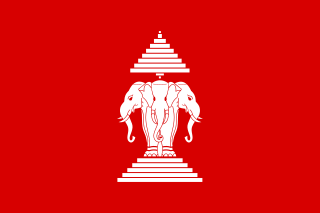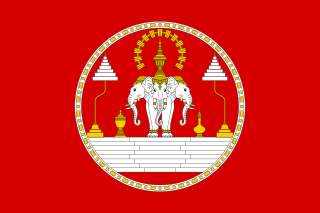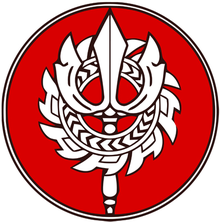
The Kingdom of Laos was a landlocked country in Southeast Asia at the heart of the Indochinese Peninsula. It was bordered by Burma and China to the northwest, North Vietnam to the east, Cambodia to the southeast, and Thailand to the west and southwest. The country was governed as a constitutional monarchy that ruled Laos beginning with its independence on 9 November 1953. It survived until December 1975, when its last king, Sisavang Vatthana, surrendered the throne to the Pathet Lao during the civil war in Laos, who abolished the monarchy in favour of a Marxist–Leninist state called the Lao People's Democratic Republic, which has controlled Laos ever since.

Prince Phetsarath Ratanavongsa (Somdej Chao Maha Uparaja Petsaraj Ratanavongsa was the 1st Prime Minister of Luang Phrabang in French Laos from 21 August 1941 to 10 October 1945, and Head of State of Laos between 12 October 1945 and 4 April 1946.

Sisavang Vatthana or sometimes Savang Vatthana was the last king of the Kingdom of Laos and the 6th Prime Minister of Laos serving from 29 October to 21 November 1951. He ruled from 1959 after his father's death until his forced abdication in 1975. His rule ended with the takeover by the Pathet Lao in 1975, after which he and his family were sent to a re-education camp by the new government.

Prince Sauryavong Savang was the youngest son of King Savang Vatthana of Laos. In 1965, he married Princess Dalavan and they had four children, Sthira Sauryavong, Dayavant Sauryavong, Balavant Sauryavong, and Krishnajina Sauryavong.

Phoumi Vongvichit was a leading figure of the Pathet Lao and an elder statesman of the Lao People's Democratic Republic.

Khamphoui was the Queen of Laos by marriage to Sisavang Vatthana, the second King of Laos. She was arrested with the rest of her family and reportedly died in a re-education camp in 1982.
The Vang Tao Incident occurred on 3 July 2000, when a group of armed insurgents and mercenaries attacked a Lao customs outpost at the southern border town of Vang Tao. The raiders, as they came to be described, were easily routed leaving six of their own dead and 27 were arrested by Thai authorities. Of those, 11 were Thai nationals.
Soulivong Savang, grandson of the last King of Laos Savang Vatthana, is the pretender to the Lao throne. Laos was a monarchy until 1975, when the communist Pathet Lao seized control of the nation, causing Savang Vatthana to abdicate his throne. Soulivong Savang lives in exile in Paris.
Thanyavong Savang is a surviving member of the now deposed royal family of the Kingdom of Laos. He was born at the Royal Palace, Luang Prabang, Laos. His father is Crown Prince Vong Savang and his mother is Princess Mahneelai.

The Royal Palace in Luang Prabang, Laos, was built in 1904 during the French colonial era for King Sisavang Vong and his family. The site for the palace was chosen so that official visitors to Luang Prabang could disembark from their river voyages directly below the palace and be received there. After Sisavang's death, the crown prince Savang Vatthana and his family were the last to occupy the grounds. In 1975, the monarchy was overthrown by the communists, and the royal family were taken to re-education camps. The palace was then converted into a national museum.

The French protectorate of Laos was a French protectorate in Southeast Asia of what is today Laos between 1893 and 1953—with a brief interregnum as a Japanese puppet state in 1945—which constituted part of French Indochina. It was established over the Siamese vassal, the Kingdom of Luang Phrabang, following the Franco-Siamese crisis of 1893. It was integrated into French Indochina and in the following years further Siamese vassals, the Principality of Phuan and Kingdom of Champasak, were annexed into it in 1899 and 1904, respectively.
Kerry Arthur Danes and Kay Frances Danes née Stewart were imprisoned in Laos as civilians on 23 December 2000 and later convicted of embezzlement, tax evasion and destruction of evidence. They were ordered to pay fines and compensation of $AUD1.1 million.

The Royal Lao Government was the ruling authority in the Kingdom of Laos from 1947 until the communist seizure of power in December 1975 and the proclamation of the Lao People's Democratic Republic. The Franco-Lao Treaty of 1953 gave Laos full independence but the following years were marked by a rivalry between the neutralists under Prince Souvanna Phouma, the right wing under Prince Boun Oum of Champassak, and the left-wing, Lao Patriotic Front under Prince Souphanouvong and future Prime Minister Kaysone Phomvihane. During this period, a number of unsuccessful attempts were made to establish coalition governments.
Princess Savivanh Savang Manivong was the daughter of King Savang Vatthana and Queen Khamphoui. She was educated in Luang Prabang, France and England, the princess served in the court of her father, the King of Laos, until the fall of the monarchy to communist forces in 1975. She went into exile in the city of Nice, France, where continued to politically pressure the communist government to provide human rights for women in Laos.

The Lan Xang Hom Khao Dynasty or Lao Royal Family was the ruling family of the Kingdom of Laos from 1904 to 1975 and the group of close relatives of the monarch of the Kingdom of Laos. King Sisavang Vong was the founder of the modern family, consisting of a number of persons in the Lao Royal Dynasty of the Khun Lo, who are related to the King of Laos, who are entitled to royal titles, and some of whom performed various official engagements on behalf of the Royal Family and ceremonial duties of State when the Kingdom existed. The Lao Royals are now based in France, where they work to achieve a change of government in Laos.

The Lao Issara was an anti-French, nationalist movement formed on 12 October 1945 by Prince Phetsarath. This short-lived movement emerged after the Japanese defeat in World War II and became the government of Laos before the return of the French. It aimed to prevent the French from restoring their control over Laos. The group disbanded in 1949.

The Order of Civic Merit of the Kingdom of Laos was established on November 20, 1950 under Royal Ordinance No. 186 by H.M. Sisavang Phoulivong, The King of Laos. It is an Order of Civic Merit for civil officials and military officers. It was awarded for meritorious and courageous service to the State in three classes. Until 1975 the approval authority was the Prime Minister of the Royal Lao Government. The current approval authority is H.E. Professor Maha Khamphoui Sisavatdy, Prime Minister of the Royal Lao Government in Exile as an elected successor to the Office of the Prime Minister of the Royal Lao Government.

Khamphoui Sisavatdy was the Prime Minister of the Royal Lao Government in Exile, serving in the position since the exiled government's formation in 2003. Khamphoui was re-elected Prime Minister in 2005 and 2010.
















